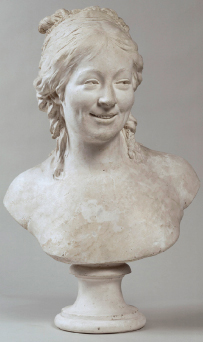Classical Forms

Houdon’s most informal portrait bust: his wife. Photo: Gerard Blot. Musée du Louvre, Paris, France © RMN-Grand Palais/Art Resource, NY.
A third feature designed to cope with the problem of musical form in Classical music is perhaps the most far-reaching. Composers and their audiences came to rely on a limited number of forms, or standard formal patterns, the most important of which are sonata form, minuet form, rondo form, and theme and variations form.
These provided a commonly understood frame of reference for composing music and appreciating it. Broadly speaking, after listening for just a short time to some new piece, an eighteenth-century music lover could always tell what sort of themes and keys it would include, when they would return, and about how long the piece would last. This frame of reference is not so obvious today, so the four Classical forms just mentioned will be taken up in some detail in Chapter 13.
The repetitions, self-conscious transitions, and emphatic cadences that are so characteristic of the Classical style all help clarify the forms. And the forms themselves were a special necessity at a time when composers were filling their compositions with contrasts of all kinds. It is a mark of the aesthetic success of Classical music that the contrasts don’t sound too drastic, because the forms control and, in effect, tame them. The seemingly inexhaustible emotional range of Classical music is directly proportional to the extent of those contrasts, on the one hand, and, on the other, to the elegance of their control by musical form.
